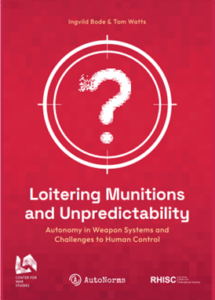By Ingvild Bode and Anna Nadibaidze
Military applications of artificial intelligence (AI) and their impacts on warfare have received much attention over the past years. Russia has been portrayed as a central actor in these debates, not least since President Vladimir Putin declared that whoever leads in the field of AI “will become ruler of the world”. Naturally, the extent to which Russia uses military applications of AI in its war against Ukraine is receiving increasingly more coverage.
In the early weeks of the war, many analysts were surprised about the relatively “low-tech” character of the Russian invasion because it seemed inconsistent with the Russian leadership’s narratives about AI being the future of warfare. Reports about the use of Russian KUB-BLA loitering munitions in Kyiv indicate that weapon systems, especially unmanned aerial vehicles (UAVs), possibly incorporating autonomous features and uses of AI, could begin to be used more in the conflict. But, so far, only drones with very limited automated and autonomous functionalities seem to play a significant role in Russia’s strategy.
This raises the question of whether the discourses of an inevitable “AI arms race” where great powers compete for leadership in AI technologies, or the uses of “killer robots” in warfare, may be overplayed. While it is challenging to answer these questions based on the observations so far, it remains important to investigate current practices of warfare and what they signal for what is considered “appropriate” in using military technologies.
Russia’s grand plans for military applications of AI and drones
Russian military and political officials have been discussing the strategic advantages and operational benefits associated with AI, and especially its applications in robotics, for several years. The integration of AI and higher levels of autonomy in the military have been priorities in the process of modernizing the Russian armed forces. Areas of interest for the Russian leadership include AI in command and control, data collection and analysis, decision-making, strategy testing, and modernising military equipment from Soviet times.
The development of unmanned vehicles, whether aerial, land, space or maritime, has been one of the key areas of investment, research, and development. Russian military analysts often focus on UAVs, or drones, as one of the most important directions to pursue in the development of modern military equipment. They argue that UAVs and especially swarms of drones are militarily useful in collecting data, identifying targets, and destroying and paralysing systems such as tanks, anti-aircraft missile, and rocket artillery systems, planes, submarines and ships. Statements from the Russian leadership over the last years also suggest that drones are considered essential in 21st century warfare. In 2020, President Putin said that UAVs, as well as robotic systems and automated control systems, are key to “determining the outcomes of current and future battles”.
These perspectives have been reinforced by how the Russian military used drones in Syria. Russia used three types of drones: small drones such as the Eleron-3 for reconnaissance, as well as medium altitude drones such as the Orion-E and loitering munitions such as the KUB for air strikes and combat missions. Because Russia does not have serial production of high-altitude and long endurance drones, the Orion-E is currently Russia’s largest armed drone. But Russia has engaged in many efforts to catch up with the leading producers, such as the US, Israel and Turkey. At the end of 2021, the Kronstadt design bureau, a privately owned company and the producer of the Orion-E, has for example launched a factory in Dubna with plans to produce dozens of large UAVs and ground control stations per year.
Military and political officials often highlight Russia’s operational experience in Syria as a justification for investing into more advanced drone models for both reconnaissance and combat purposes. Officials have also referred to the use of drones and loitering munitions in the 2020 Nagorno-Karabakh war as a “successful” way of conducting warfare and cited this experience as influential for Russian tactical exercises. More recently, in January 2022, the Russian and Belarusian troops that were part of the Collective Security Treaty Organization (CSTO) mission in Kazakhstan used drones for reconnaissance and patrolling of airports. This mission, labeled as “peacekeeping” by the Russian government, was called for by Kazakhstan’s President Tokayev to counter protests.
The invasion of Ukraine: what we know so far
The developments discussed above suggest that the Russian leadership may have planned an important role for more advanced military technology in the invasion of Ukraine. Yet, in the first weeks of war, many analysts found themselves surprised by the apparent lack of “high-tech” equipment and strategy on the part of the Russian forces. Russia’s 60km-long military convoy just outside of Kyiv, for example, was long immobile because of significant logistical problems, such as low-quality tyres and inadequate vehicle maintenance. There are also visible issues with the professionalisation of the military and the personnel’s ability to use the equipment. Such pictures did not speak of the type of warfare associated with a highly technologised great power.
Drones
Even drones did not initially seem to play a large role in Russia’s campaign, as noted by many analysts. This impression may also have been due to the fact that the majority of reconnaissance drones in Russia’s arsenal, such as the Eleron-3, are too small to be easily spotted. At the same time, significant Russian casualties especially among small military units in the first weeks of war indicate that they were, in fact, operating without the support provided by such reconnaissance drones.
Ukrainian accounts about Russian drones soon emerged. On 25 February, the Ukrainian armed forces reported Russian UAVs flying at a height of approximately 1km along the Black Sea coast and the Danube river. On 26 February, Ukrainian border protection services have reported that they managed to shoot down a drone which had for goal to attack a Ukrainian maritime guard ship in the Black Sea.
Gradually, more information is becoming available. Social media reports have noted the potential use of E95M target drones, possibly to test Ukrainian air defence systems. Some images and videos also suggest the use of drones for surveillance and intelligence purposes from the manufacturer ZALA AERO, subsidiary of the Kalashnikov Concern group and part of the Rostec corporation.
The Russian Ministry of Defence (MoD) has also been releasing some information on the types of weapons used. On 4 March, it reported that the use of the Orion drones produced by Kronstadt, named Inokhodets by the Russian armed forces, has successfully destroyed the Ukrainian Aidar Batallion on the territory of the Donetsk self-proclaimed republic. The Orion long-range medium-altitude UAV can stay up in the air for 24 hours, according to the state media, and has previously been tested by the Russian forces in occupied Crimea. On 13 March, the MoD released a video of the use of Forpost-R UAV for reconnaissance, fire adjustment and combat functions. Initially produced under an Israeli license, this model was adapted in Russia and recently gained the capability to strike, with the MoD signing a contract for the supply of Forpost drones in 2021. On 30 March, the MoD demonstrated in a video its use of Orlan-10 drones for reconnaissance and spotting purposes, although this drone model also has the possibility to be employed for combat.
Reports now suggest that Russian forces have also used KUB loitering munitions in Kyiv. According to their manufacturer ZALA AERO, these are “high-precision” small-size weapons designed to destroy remote targets and have the potential to “deliver a special load to the target coordinates, which are set manually or on the image from the guidance system”, presumably a preloaded data set. Media reports have described the “highly accurate” drone as being guided by video imagery from its own camera. The Kalashnikov Group also highlighted the system’s ability to work in a swarm and to be a “universal means of destruction”. At the end of 2021, the MoD has reportedly ordered several hundreds of KUB drones from ZALA AERO, and the latter stated that the systems would be ready for use by the end of the year.
Experts also name the Lancet system as one of the potential weapon systems that could be used in at a later stage of the war. Kalashnikov presents this system as an “intelligent multi-tasking weapon that is able to independently find a given target and hit it”. It is also said to possess a “television guidance channel”, and, unlike the KUB UAV, it “does not lose video contact with the operator until the actual contact with the target”. As several other Russian UAVs, Lancet has been reportedly used in Syria.
The first evidence Russia is using loitering munitions in Ukraine. This looks like a Kalashnikov ZALA Aero KUB-BLA loitering munition. https://t.co/O832OSUKSm pic.twitter.com/cXzuwgciut
— Rob Lee (@RALee85) March 12, 2022
AI applications
Many applications of AI are not visible, for instance those related to AI-based automation in data collection and command and control. AI could be used in the areas of data analysis and surveillance of images uploaded on social media – which is partly why the Ukrainian authorities have asked citizens not to take pictures of military equipment. Experts also note the potential use of AI in interoperability of different weapon systems and the interpretation and management of information from the battlefield. In this context, social media users have argued that the Russian military may have put numerous micro-tasks to locate ports, medical facilities, or bridges on the micro-tasking platform Premise. The performance of such low-paid micro-tasks, chiefly data or image labeling, also referred to as “ghost work”, is a necessary but invisible element of training/building algorithms.
Information war
Apart from the actual role of military applications of AI in the war in Ukraine, discourse about them figures significantly in the “information war”. Russian governmental sources often talk about strikes carried out by “high-precision weapons” as representing their main military strategy in Ukraine. Their “high-precision” is also a familiar, supposed characteristic of autonomous weapon systems, figuring significantly in international debates and employed by many states, including the US. By using this language in the context of the Ukraine war, Russia claims to be a technologically-advanced state that uses military force in a discriminate, restricted way – claims that are clearly aimed for domestic consumption and to support the Russian leadership’s narrative that the operation is “not directed against civilians”.
For example, the Russian MoD representative Igor Konashenkov has been declaring that Russian armed forces “do not carry out strikes on civilian objects”. Videos and footage of drones, as well as other “precise” weapons, is a way of misrepresenting Russia’s operations for the domestic audience. Following this official line of propaganda, one of the main state channels, “Channel One” reported on 30 March that the Pantsir missile defence system employed by Russian forces destroyed a Ukrainian UAV “to protect the civilian population from attacks” by the Ukrainian army. The Pantsir system is said to be capable of functioning in a fully automatic mode.
Although Russia does indeed use some “precise” weapons such as drones and cruise missiles, the widespread urban warfare in Ukraine’s major cities such as Mariupol and Kharkiv, reports of uses of cluster munitions and incendiary bombs, as well as the growing civilian death toll, prove that calling Russia’s war “highly precise” is simply not tenable. But these kinds of claims remain notable for the type of language that they are using.
Challenging the “AI arms race” expectations?
It remains to be seen what kind of roles military applications of AI and drones will play in the Ukraine war.
Defence Minister Sergei Shoigu said at the end of March that it was important to maintain the pace in terms of acquiring military technology such as robotic systems, information support and electronic warfare. He noted that, despite sanctions, state defence orders are being carried out as planned.
But the past weeks have shown that weapon systems with autonomous features only play a limited role in current Russian strategy. Russian claims about the “high-tech” nature of its military as well as expectations that have been advertised in previous plans and statements, including based on their Syrian experiences, appear to have been overblown.
Further, with the Western sanctions hitting the Russian economy hard – and including limits on technology imports such as semiconductors – as well as tens of thousands of IT specialists fleeing the country, the Russian leadership’s claim to becoming one of the leaders in AI-based technologies, including in the military sphere, is even more unlikely to become a reality.
This inconsistency showcases issues with the narratives about AI inevitably leading to a new global “arms race” between great powers seeking AI leadership. Many policymakers in the West, for instance, call to invest more into modern military technologies based on the developments abroad, including in Russia. Robotic systems, AI, and autonomy remain important in studying warfare, but narratives about an inescapable “AI arms race” are not fully supported by the discrepancy between what Russian authorities have advertised their military capabilities to be and what they are actually doing on the ground. The prospects of fully autonomous weapons, or so-called “killer robots”, have also not been confirmed as the current systems in use have only very limited autonomous features, if what their manufacturers are claiming is true.
This does not make the debate about weaponised AI less important. Despite the reality challenging expectations set by some policymakers or campaigners against “killer robots”, AI-based technologies being part of the war in Ukraine highlights that many of its uses might become normalised and de facto “accepted” practices in warfare – and the need to continue examining these practices in detail.











